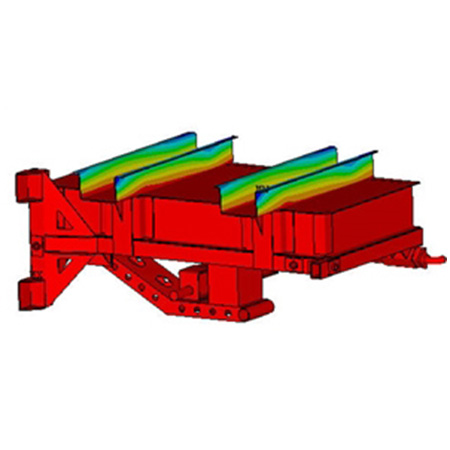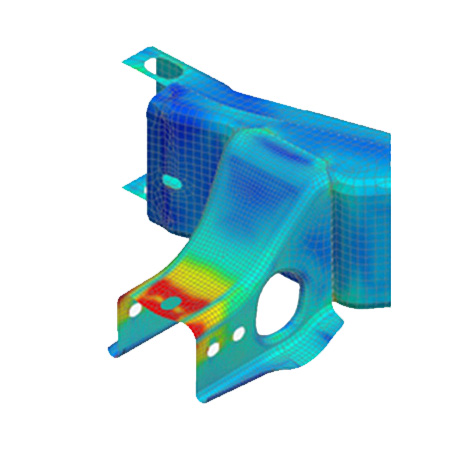

MOBILE COMMUNICATIONS SYSTEMS
Many communications systems require mobility in environments such as off-road, standard highway, aircraft, shipboard, rail, etc. Often the system is mounted in a metal or composite shelter. Decisions need to be made early in the development cycle such as what shelter construction will be used, what manufacturing methods will be needed, what isolation methods if any will be required to protect the electronics, what thermal requirements will exist within the shelters and electronics, and what cost tradeoffs will be made to ensure survivability at a reasonable cost. The figure shown above represents a finite element model of a typical shelter/communication system. This model can be used to address the critical decisions that the supplier needs to make.
FORCING FUNCTIONS
Before performing a simulation of dynamic response to specified loads, the specification must be converted into mathematical forcing functions for road transport, air transport, nuclear over-pressure, etc., which can be applied to the computer models. With these forcing functions, a dynamic analysis can predict system response levels for comparison with system performance specifications, material limits, and known functional requirements.
VEHICLE DESIGN
Various design concepts are developed, considering alternative materials plus fabrication and assembly concepts. Preliminary analysis helps select the "best" concept, followed by detailed analysis to determine stresses and deflection. Graphic results make interpretation easy for the design engineer. A detailed design is then created. Final design optimization for stress reduction and elimination of over-design is achieved using the structural and detailed finite element models.
DYNAMIC MODELING
Once the preliminary design concepts have been developed, mass properties, geometry, and stiffness are defined and used to create finite element models which include the previously determined forcing functions. Modeling involves modal analysis, component mode, and forced response in time or frequency domain simulations.
DYNAMIC TESTING
Modal testing is performed to validate the modal model and to assure an accurate dynamic representation of the vehicle. The data collected during hydraulic or electromagnetic excitation can be used to define vibration mode shapes of the overall vehicle and to measure transmissibilities of components. A key objective is refinement or test verification of finite element models for future design analysis predictions or demonstration of satisfaction of requirements.
COMPONENT TESTING
Need for conservatism in design can be reduced and more challenging performance standards met by testing key components or prototype joints, or elements, to determine true performance limits.
INTERPRETING AND PREPARING SPECIFICATIONS
Equipment mounted in a mobile system can sustain several different types of loads which must be considered in the specifications. The specification must state whether the environment can deliver vibrations at discrete frequencies or if the environment is random, shock, or static in nature. Different types of environments can be compared, but only after conversions are made to correctly account for the different effects caused by various types of loads. A successful, cost-effective design depends on a valid comparison among the component test environment, analytically simulated environment, and real vehicle environment.
Wenzlau Engineering, Inc. was established in 1956 to provide engineering solutions for the protection and mobilization of sophisticated electronic systems. We remain focused on our initial mission to provide each customer with a single source for mobile products and services resulting in a solution that is cost effective, quick to market and consistently reliable. Our extensive capabilities allow us to assist our clients throughout a program, including conceptualization, business development, engineering, project management, manufacturing, testing, and after sales support.